The fund finished 2023 well and returns have continued into 2024 with the DKAM Capital Ideas Fund returning 34.59%1 for the first half of the year. Portfolio companies are performing well, and the macro environment is playing out as predicted.
An overview of the catalysts behind the recent performance and our forecast for small caps can be found HERE. This has been one of our most read commentaries and we urge investors to read it as a precursor to this newsletter.
The main macro forces can be summarized as:
1. Peak Interest Rates
2. Cash on the Sidelines
3. Historically Cheap Valuations
We believe we’re in the first year of the next 5-6 year cycle for small caps and we are currently seeing the best growth to value trade-off in our fund’s history.
Large versus Small
It was the best of times, it was the worst of times, it was the age of wisdom, it was the age of foolishness…
Dickens started A Tale of Two Cities with this famous introduction. We’re not trying to be grandiose by quoting Charles Dickens, but it seemed fitting for this edition of the newsletter. The starting point for this newsletter is how well the largest companies have done over the last few years. We use many of these businesses every day, they are growing, extremely profitable, and have rock solid balance sheets. That being said, from a stock market perspective we’re at the point where the average investor’s exposure to these companies has reached stunning levels.
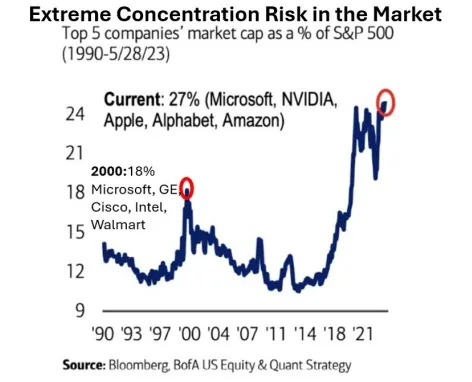
It has been the best of times for these phenomenally great and phenomenally large companies. This performance, in our view, has come at the expense of smaller companies. The difference in valuations of these two segments has also reached stunning levels, which has led to small caps underperforming for quite some time. Again, we reference more specifics to the catalysts in the report linked above, but we believe the pieces are in place for this trend to begin to reverse.
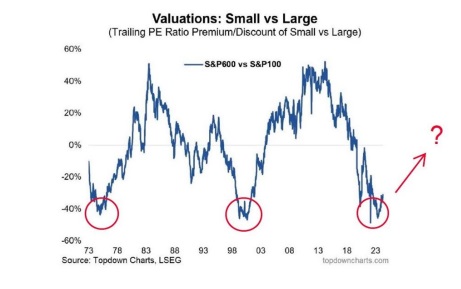
The issue arises when one wants to diversify their portfolio. The largest ETFs hold these large caps in significant size. In order to increase exposure to small caps, the common choice would be to own one of the small cap ETFs that focus on mimicking the Russell 2000 Index (the smallest 2000 stocks in the Russell Index). For some this may be appropriate but we broke down what you would actually own by investing in that index.
Haves and Have Not
We combed through the IWM (Russell 2000 ETF) and broke out the stocks into our own sub-categories. Most of these categories aren’t mutually exclusive. The first table is exposure to companies we would categorize as poor quality. The main point being 43% of the index is made up of unprofitable businesses, with a majority carrying debt on the balance sheet. This is why the consensus view is “investing in small companies is risky.”
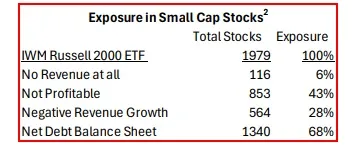
There are good companies within the Russell 2000 and we own a few in our fund. However, based on factors we use as simple screens we came away with the conclusion that we would be comfortable owning less than 2% of the stocks in the index. This doesn’t seem like an appealing option for small cap exposure.

We obviously think there are much better ways to invest in small businesses. Large successful businesses start as small businesses and by focusing on growth, real cash profitability and valuation and investor can find these businesses early on.
An interesting point to make is that the valuation difference between large and small is so wide and that includes many overvalued or poor businesses within small caps. It reinforces the point of how cheap some of the profitable and growing businesses really are. Reinforcing this point is the relative P/E of small versus large to their historical average, not just the relative difference.
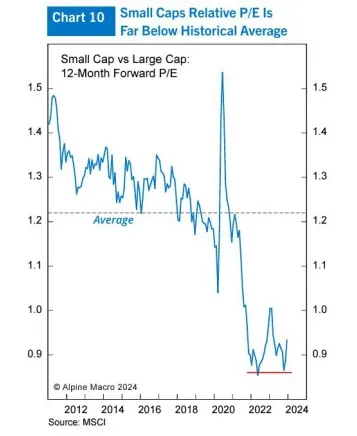
If you would like to invest in small caps without having to own the inferior companies that get associated with this asset class, please reach out to discuss.
Company Notes
We provide comments on three stocks below which are prime examples of small cap stocks that are executing day to day, are very profitable, growing, and should benefit from the renewed focus on small caps.
Zedcor (ZDC)
We have addressed Zedcor as one of our largest investments a few times now. Based on the stock doing well recently, we have received questions about it. Is it expensive, is there a competitive advantage and what is our long-term outlook?
When it comes to competitive advantage, most want to hear about proprietary technology or exclusive licenses. In order to generate the type of margins that Zedcor does and maintain them, this is an important question to answer. We are going to refer to the greatest expert on the manner, Charlie Munger.
We are all influenced either subconsciously or consciously on what others do. We don’t like to be the one that is out of step. This psychological effect is called social proof. Social proof leads to more sales, which leads to more distribution, which spins the flywheel.
Zedcor, even though they are new to the market, are now doing business with Amazon, BestBuy, Home Depot, D.R Horton etc. They are also winning business from competitors who don’t supply in-house monitoring or who outsource their monitoring overseas. As the company gets more successful and has more resources they can increase their specialization. An example would be Zedcor is currently working on specialized security poles specifically for home builders like D.R Horton. If you see their product in person versus many of the competitors, its easy to see why they are winning market share.
Another tailwind is this type of technology becoming the industry standard for security in order to satisfy Builders Risk Insurance. The industry term of Course of Construction Insurance (COC) covers building materials, physical property and partially constructed buildings.
Some of the types of projects requiring COC insurance include:
- Residential New Builds
- Residential Renovations
- Custom Homes
- Commercial New Builds
- Commercial Renovations
- Tenants Improvement Projects
- Civil & Municipal Contracts
- Road Building
- Bridge Building
- Pipelines & Utilities
Businesses looking to save costs can add reducing insurance expenses to the list. For their targeted use cases, the towers are cheaper and more effective than inperson security guards, plus have shown to reduce theft.
We believe the stock is till very misunderstood and cheap based on future cash earnings. Next quarter you should start to see the growth on paper, but tracking their fleet in the field is more useful. Demand is outpacing supply which is increasing their utilization rates and margins. To find long-term compounders, you want a company that can re-invest cashflows back into the business at high rates of return for a long time. Each deployed tower is highly profitable. We estimate +25% ROIC per tower. We expect over 80% revenue growth in 2025 with even higher earnings growth.
We believe they are just scratching the surface of the addressable market. They currently have over 1,000 towers. Many of their current customers who recently started using them have 1,000-2,000 locations just themselves. You can see a path where they get to 10x the size they are now and they’re already very profitable with increasing margins.
Potential locations noted in their investor presentation include:
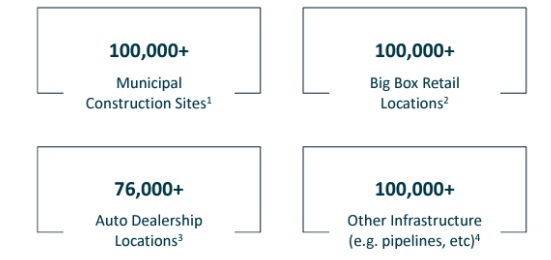
A final question to answer is why now? We covered the new industrial revolution in detail HERE. Zedcor’s technology solution wasn’t possible until very recently. With multiple technological advancements, they are now able to combine high resolution video & radar with the ability to monitor thousands of incidents with AI and then store this information in the cloud, while being able to access enough bandwidth either through cellular or satellite to reliably send all this data in real time. It hasn’t been until recently where one of these links in the chain wasn’t either advanced enough or cost prohibitive. At first glance, it may not seem like it, but Zedcor is much more advanced and at the leading edge of the industry.
Cipher Pharmaceuticals (CPH)
Cipher might be a familiar name as we invested in the company from 2013-2015. At the time they had a very successful acne product and were growing extremely quick and generating a lot of cash. We exited after management made a few missteps and growth declined, but the stock did very well over that period. Last year we met with the new management team and were impressed with the turn around and long-term strategy. Cipher has a core portfolio of highly profitable products with a pipeline of more to come.
Cipher has been sitting on a significant amount of cash and looking for a strategic acquisition for the last 2 years. They just announced the acquisition of ParaPro’s rights to Natroba plus their 50-person US sales force. Natroba is profitable and growing and more than doubles Ciphers revenue and earnings. Cipher now has the infrastructure to become a significant pharma company in North America.
There are a lot more attractive catalysts for Cipher, like foot fungus and scabies (seriously). Please reach out if you would like to discuss in more detail.
VitalHub (VHI)
VitalHub is one of our largest investments and we have covered it in detail over the years. VHI has been consistently growing both organically and through acquisition. The most impressive aspect has been the growth in profit margins, which we think still has a lot of room to run. For a relatively small company, they have over $70m of cash and no debt on the balance sheet. On July 30th, they announced the acquisition of Medcurrent, which sells OrderWise, a clinical decision support software. OrderWise analyzes medical imaging tests using criteria inputs and AI to determine whether certain tests are appropriate for treatment, saving hospitals money. This will provide VitalHub’s sales team with another opportunity to cross-sell plus expand OrderWise to other fields. This software is highly complementary to VitalHub’s current decision support platform for admitting/discharging patients.
The deal looks to be structured well with $12m cash up front and $22m in earnouts based on aggressive growth targets over the next 36 months. This management team and board are very disciplined and have shown to acquire extremely well and increase margins significantly after integration.
Investors, like ourselves were/are expecting a big deal and based on this deal we still expect a large deal and further tuck-ins this year. VitalHub’s margins continue to expand as they scale and organic growth has been impressive. We expect them to continue to execute well on their current business plus deploy a decent amount of capital by year-end, which would position the stock price much higher than it is today.
Final Thoughts
Not only are the valuations still extremely attractive, but they are off the charts better value versus large caps at the moment. Obviously, many of the largest cap stocks are great businesses with good growth, margins, and rock-solid balance sheets. But an investor doesn’t need to sacrifice growth, margins, and balance sheet in order to invest in small caps. Yes, the main small cap indexes are full of companies with too much debt, thin to no margins, or simply surviving on hype. However, large successful companies start as small companies, and there are more than enough right now to own in a concentrated portfolio.
Please reach out directly if you have any questions about our investing strategy, any of the points supporting our economic views, or specific companies.
Sincerely,
Jason & Jesse

